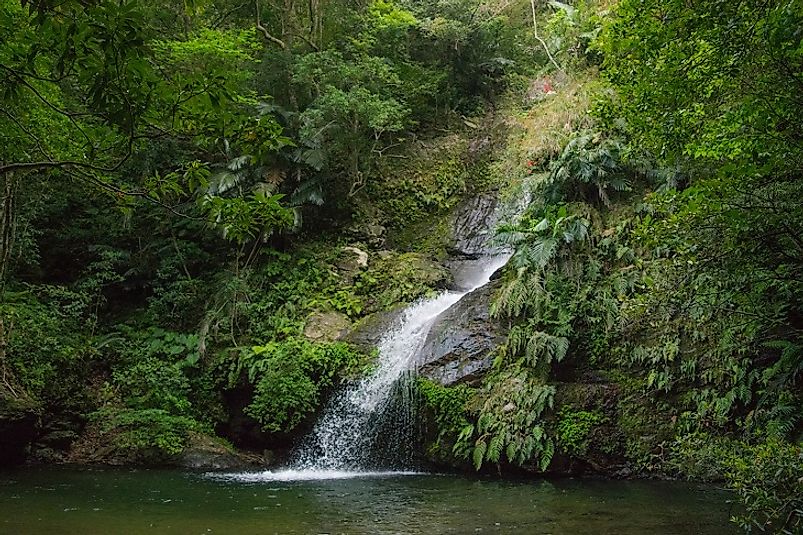Where Are The Ryukyu Islands?

5. Description
The Ryukyu Islands are a chain of islands (archipelago) in Japan that stretches for a distance of 1,100 kilometers southwestwards from the Japanese island of Kyushu towards northeastern Taiwan. The Ryukyu Islands cover a land area of approximately 3,090 square kilometers, and this area demarcates the boundary between the Philippine Sea in the east and the East China Sea in the west. The 55 islands of Ryukyu are divided into three principal groups, or sets. Namely, these are the northern-lying Amami Islands, the central Okinawa Islands, and the southernmost are known as the Sakishima Islands. The island of Okinawa, with a land area of 1,176 square kilometers, is the largest among the Ryukyu Islands.
4. Historical Role
Between the 15th and 19th Centuries, the Ryukyu Islands were under independent rule. The Ryukyu kings fostered the development of trade between the island communities and the Asian and Southeast Asian countries that surrounded them. In 1609, the islands were invaded by soldiers dispatched by the daimyo of Satsuma in Japan, and, though the kings of Ryukyu managed to hold on to their rule, they were forced to pay hefty tributes to this Japanese daimyo. Finally, in 1879, the islands formally came under absolute Japanese rule. During the Second World War, the Battle of Okinawa, which claimed the lives of thousands of Japanese and American soldiers alike, was fought on the Okinawa Island of the Ryukyu archipelago. After World War II was over and Imperial Japan had been defeated, the Ryukyu Islands came under U.S. control. However, in 1972, Japan once more was given the control of the Ryukyu Islands, handed over from the U.S., and retains ownership to this date.
3. Modern Significance
The Ryukyu Islands, unlike most other islands of Japan, are not heavily industrialized. Agriculture and fishing are the major occupations of the people of these islands. Rice, sweet potatoes, and other food crops are grown widely for local consumption, while Ryukyu's major exports are comprised by such agricultural products as sugar and pineapples. Tourism is also another major source of income for the local economy of this region. Industries are few, and most of the industrial expansion occurred here during the United States' rule between 1945 and 1972. Lacquer and pottery production are important traditional industries of the Ryukyu Islands. Other small scale and cottage industries are found in the cities of Naha and Okinawa on the Ryukyu Islands.
2. Habitat and Biodiversity
The Ryukyu Islands. like the other islands of Japan, lie in the “Pacific Ring of Fire”, and hence are highly susceptible to earthquakes and volcanic eruptions. The islands, of coral or volcanic origin, have a rugged landscape. The climate of the region is subtropical in nature, with much precipitation and frequent typhoons. Coral reefs along these islands are of extreme ecological significance, and are included as part of the World Wildlife Fund's Global 200 eco-regions. Many endemic species, like the near threatened Ryukyu Flying fox, the critically endangered Iriomote cat, and the endangered Ryukyu Long-tailed giant rat, inhabit these islands. Japanese paradise flycatchers, the Ryukyu kingfisher, Ryukyu minivets, Ryukyu Wood pigeons, and Amami woodcocks are some of the unique bird species of the Ryukyu ecosystems. High rates of endemism also prevail among the reptilian and amphibian species of these islands, meaning many of such native species can be found nowhere else in the world.
1. Environmental Threats and Territorial Disputes
The ecological significance of the Ryukyu Islands can be easily seen from the large number of endemic species found on this island. These species, found nowhere else in the world, are at high risk of extinction if their habitats on these islands are lost. Climate change-induced warming of ocean waters threatens to damage the coral reefs of these islands, and thus affect the habitat of a large variety of aquatic species inhabiting these coral reefs. The Ryukyu Islands are also highly susceptible to volcanic eruptions, earthquakes, tsunamis, and typhoons. A large-scale disaster could wipe away all of the existing species from these islands. Besides these ecological and environmental threats, tension also prevails on the Ryukyu Islands on the political front. Despite the governance of the country being controlled by Japan, the United States' military still maintains large Air Force bases on and around the Ryukyu Islands. This foreign military presence often creates local unrest and controversies in the region.











